On April 18, 2018, the Appellate Division, Second Department issued a decision as noteworthy for its important substantive holding as for its dramatic context: People v. Hargrove, affirming the Supreme Court’s grant of a motion to vacate a 1992 conviction, is the first appellate decision to address the elephant in the Brooklyn criminal justice system’s room—retired NYPD detective Louis Scarcella, whose investigative work was at issue in a dozen convictions vacated to date with more possibly to come. Not only has the decision riveted those involved with and otherwise following the Scarcella cases, it contains a bold restatement of the governing state standard for motions to vacate convictions based on newly discovered evidence—the Second Department rejects the long-standing common law requirement that the newly discovered evidence must not be merely impeaching, as contrary to the plain text of C.P.L. § 440.10 (1)(g). While a long time coming, the thorough decision was well worth the wait from a substantive perspective and a “must read” for anyone following Scarcella cases.
Background
Scarcella was a detective with the NYPD from 1981 until 1999, based in Brooklyn. In 2013, then Brooklyn District Attorney Charles Hynes vacated a 1991 murder conviction for which Scarcella had been partially responsible, noting that his Conviction Integrity Unit had “uncovered some questionable conduct” on the detective’s part. Among other issues, an eyewitness affirmed that a detective, possibly Scarcella, told him who to pick out of a lineup. DA Hynes, and his successor, Kenneth Thompson, committed to an unprecedented review of other convictions resulting from Scarcella investigations; according to the NY Times, the number of cases on the review list ran to more than 70 at its peak. The Second Department, in its recent decision, minces no words, describing Scarcella as “a police detective whose investigatory record is so troubling that the District Attorney has resolved to review every single one of his cases.” People v. Hargrove, No. 2015-04231, 2018 N.Y. App. Div. LEXIS 2614 (2d Dep’t Apr. 18, 2018).


 Courtesy photo
Courtesy photo




